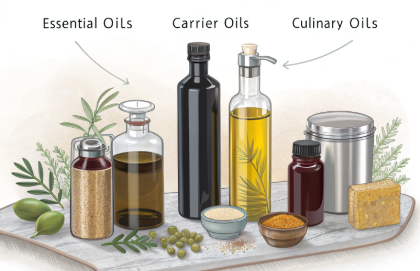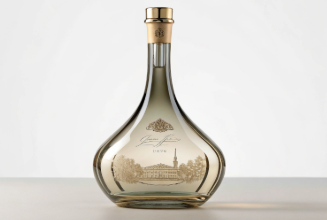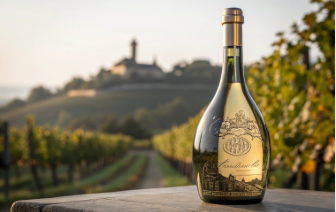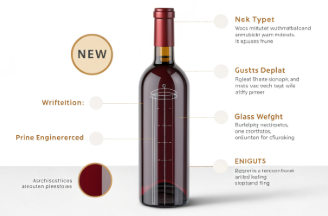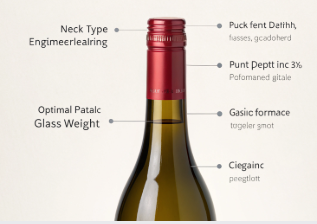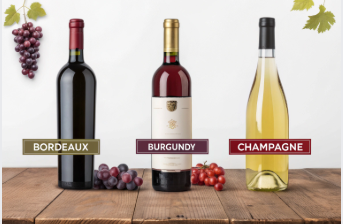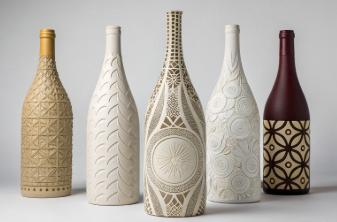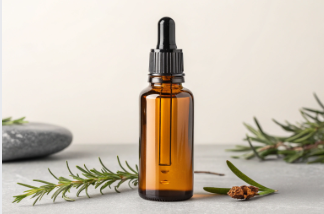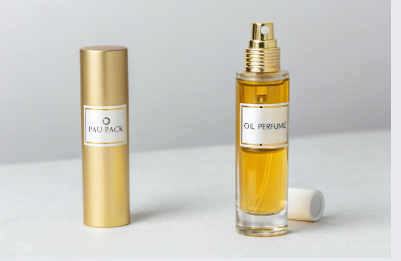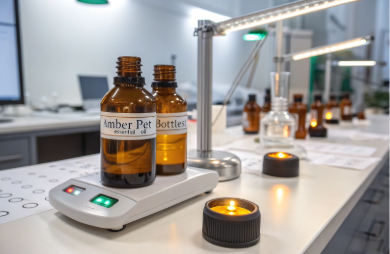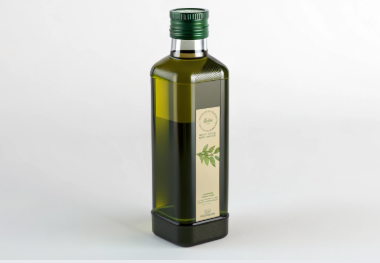Choosing a wine bottle isn’t just a packaging decision—it’s a statement. The shape, color, weight, and finish of your bottle are the first things your customers see and feel. Long before they taste the wine, they’re forming an opinion based on what’s in their hand.
A well-chosen wine bottle boosts brand identity, communicates product quality, and sets the tone for customer expectations—making it a vital element of your packaging strategy.
In this guide, I’ll help you understand the core considerations that go into selecting the perfect glass wine bottle for your brand, and how a strategic partner like PauPack can help bring your vision to life.
Why your wine bottle shape says more than your label
Most consumers don’t know wine bottle types by name—but they recognize the message each shape sends.
The shape of your bottle cues your customer about what type of wine they’re holding, how it was made, and where it sits in the quality spectrum.
Dive Deeper: Understanding Wine Bottle Shapes
| Bottle Style | Common Use | Brand Signal |
|---|---|---|
| Bordeaux | Cabernet, Merlot | Classic, robust, structured |
| Burgundy | Pinot Noir, Chardonnay | Elegant, soft, artisanal |
| Alsace/Flute | Riesling, Gewürztraminer | Fresh, crisp, aromatic |
| Champagne | Sparkling wines | Celebration, quality |
| Tapered/Custom | Rose, blends | Modern, playful, differentiated |
Choosing the right shape is not just about tradition. It’s about matching your wine’s story with the emotional expectations of your audience. At PauPack, we help brands craft custom silhouettes that reinforce brand positioning—while maintaining bottling line compatibility.
How to choose the right glass color and clarity for your wine
Color isn’t just about looks. It’s about protection, shelf appeal, and even regulation.
Glass color plays a vital role in wine preservation and consumer perception—especially for wines sensitive to light and oxygen.
Dive Deeper: Glass Tint and Branding
| Color | Protection | Wine Type | Brand Vibe |
|---|---|---|---|
| Amber/Brown | Excellent | Fortified or natural | Rustic, organic, traditional |
| Olive Green | High | Red wines | European heritage, premium |
| Champagne Green | Medium | Sparkling wines | Elegant, timeless |
| Flint/Clear | Low | White, rose, niche reds | Modern, bold, transparent |
While flint glass allows full product visibility (great for rosé and branding), it provides little UV protection. At PauPack, we offer UV-treated clear bottles and dual-layer glass to balance aesthetics with stability.
What functional features matter most in bottle performance
A beautiful bottle is useless if it compromises function. The wine industry demands performance at every step—from bottling line to consumer table.
Critical features like neck type, punt depth, shoulder angle, and glass weight affect filling, sealing, transport, and customer experience.
Dive Deeper: Engineering Matters
-
Neck & Mouth: Cork vs screw cap compatibility. Corks need consistent ID tolerances.
-
Punt Depth: Traditional style vs stacking logistics. A deeper punt gives visual weight but reduces volume.
-
Shoulder Style: Tall shoulders are better for aging red wines. Sloping shoulders suit lighter varietals.
-
Bottle Weight: Heavier = premium feel, but higher transport cost. Eco bottles reduce carbon footprint.
At PauPack, we engineer wine bottles for both shelf appeal and bottling line performance. We match bottle dimensions to your machinery and closure system to ensure flawless runs.
How sustainability is shaping modern wine packaging
Today’s wine drinkers want more than flavor—they want a brand that aligns with their values.
Sustainable wine packaging is now a market expectation. Lightweight bottles, recycled glass, and carbon-neutral production are reshaping the category.
Dive Deeper: Green Glass Strategy
Key sustainability shifts:
-
Lightweight bottles: Cut shipping emissions without losing strength.
-
Recycled glass content: Lowers energy use during manufacturing.
-
Plastic-free labeling: Uses acid-etching or paper alternatives.
-
Renewable energy: Many wineries now choose packaging made in solar-powered factories.
At PauPack, we offer 100% recyclable glass bottles, eco-friendly closures (like natural cork or bamboo), and acid-etched decoration to eliminate plastic waste. All our production lines are powered by renewable energy and designed for low water usage.
Why PauPack is a trusted partner for custom wine bottle solutions
You can find glass bottles anywhere. But finding a supplier that understands wine, branding, engineering, and sustainability? That’s rare.
PauPack offers full-stack wine bottle development—from concept sketches to logistics—helping wineries launch with confidence and scale with consistency.
What We Offer:
-
Custom molds: Bring your signature silhouette to life
-
Global sourcing: Over 3 million sq ft of warehousing
-
OEM/ODM service: From cap to carton, we’ve got it covered
-
Premium finishes: Etching, frosting, embossing, UV screen printing
-
Small MOQs: Starting from 1,000 pcs for boutique runs
We’ve helped new wine brands launch in Napa, Tuscany, and Adelaide. Whether you need 5,000 bottles for a test vintage or 500,000 units for international export, PauPack is your partner in premium packaging.
How wine type influences bottle selection
Each wine varietal has a personality—and your bottle should reflect it.
The structure, tannin level, and aromatic profile of your wine help determine the most suitable bottle shape, closure, and glass treatment.
| Wine Type | Ideal Bottle | Closure Preference | Glass Color |
|---|---|---|---|
| Full-bodied Reds | Bordeaux or heavy Burgundy | Cork | Dark green or amber |
| Light Reds | Burgundy or Alsace | Cork or screw | Champagne green |
| Aromatic Whites | Flute or Bordeaux | Screw cap | Clear or light green |
| Sparkling Wines | Champagne | Cork + cage | Thick, dark green |
| Natural Wines | Custom or recycled | Natural cork | Flint or eco-mix |
Matching your packaging to the wine’s technical profile enhances consumer expectations and supports proper aging and storage.
Understanding consumer psychology in wine bottle design
Buyers judge with their eyes before they read with their minds. Packaging psychology is a powerful conversion tool.
Visual design elements like shape symmetry, label placement, cap finish, and tactile feel directly influence perceived value and purchase intent.
| Design Feature | Consumer Impact |
|---|---|
| Heavy bottle | Signals premium, aged, limited edition |
| Unusual silhouette | Creates curiosity and shelf standout |
| Clear glass | Suggests freshness, lightness |
| Matte or frosted finish | Implies elegance and restraint |
| Hand-drawn label | Appeals to artisan and boutique lovers |
At PauPack, we’ve worked with wineries that increased DTC conversion by over 20% just by changing bottle finish and switching to minimalist caps.
Regional market preferences for wine bottle styles
What sells in France may not work in California. Market-specific bottle preferences can make or break your export strategy.
Wine bottle expectations vary dramatically across countries and consumer demographics—requiring thoughtful regional packaging choices.
| Market | Preferred Bottle Style | Color | Notes |
|---|---|---|---|
| USA | Clear or bold custom bottles | Clear/black | Emphasis on branding, innovation |
| France | Traditional Bordeaux/Burgundy | Green | Classical forms, authenticity key |
| Australia | Light bottles for export | Eco/flint | Strong sustainability demand |
| Japan | Compact, elegant bottles | Dark green | Giftability and display matter |
| Germany | Flute/Alsace for whites | Olive/amber | Strict form-function consistency |
We advise global clients at PauPack to align SKUs with each market’s cultural norms—while maintaining brand consistency across borders.
Key considerations for exporting wine in glass bottles
Glass bottles add weight, fragility, and regulatory complexity to global shipments—but they’re still the gold standard.
To export successfully, wine producers must navigate bottle weight limits, labeling laws, climate conditions, and breakage risks.
Tips from the field:
-
Bottle weight: Some countries like the UK are introducing taxes based on glass weight.
-
Closure rules: Canada requires tamper-evidence; China prefers corks in luxury tiers.
-
Label placement: Must be adapted to left/right reading direction and legal layout.
-
Climate packaging: In hot regions, UV-treated bottles and insulated shipping packs reduce spoilage.
-
Breakage control: At PauPack, we offer foam-insert cartons and drop-tested shipping containers for global fulfillment.
How innovation in glass shaping elevates packaging appeal
Beyond classic styles, custom shapes are redefining modern wine branding.
Creative glass shaping turns bottles into brand assets—especially for rosé, blends, and concept-driven wines.
Innovation examples:
-
Flat bottles: Eco-conscious and letterbox-friendly for e-commerce
-
Curved shoulders: Soft, feminine aesthetic for lifestyle wines
-
Embossed base logos: Subtle branding that catches light
-
Geometric cuts: Premium shelf presence for collector editions
-
Tinted patterns: Visual complexity without stickers or ink
At PauPack, we prototype shapes with brand teams—creating signature molds that blend engineering and storytelling. From sketch to shelf, we help your bottle become part of your wine’s legend.
Conclusion
From varietal to visual to voyage, every element of wine packaging matters. The right glass bottle not only protects your product—it enhances it, sells it, and supports your brand mission. As your global packaging partner, PauPack brings innovation, sustainability, and elegance to every bottle your wine deserves.




